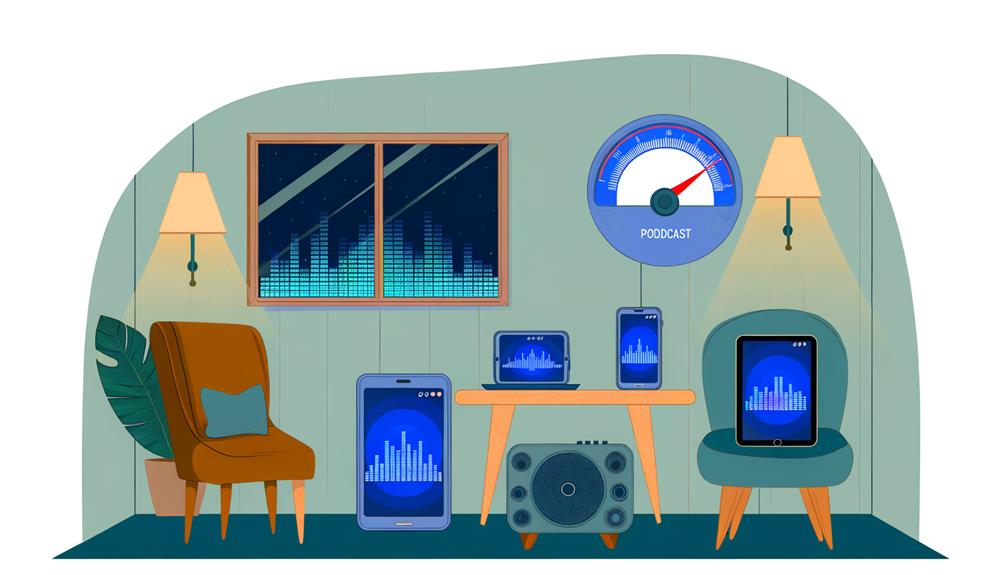No products in the cart.
Mastering your tracks for Apple Music is essential to make sure they align with the platform’s –16 LUFS normalization standards, guaranteeing a consistent and high-quality listener experience. By fine-tuning your tracks’ EQ settings and managing loudness, you not only enhance audio fidelity but also prevent distortion, maintaining quality across all devices. This not only helps in meeting the competitive industry standards but also increases your music’s discoverability and listener engagement, setting your work apart. Mastering effectively positions your music for success in the streaming landscape, opening doors to broader opportunities. There’s much more to uncover on how these techniques can transform your music career.
Contents
hide
Key Takeaways
- Mastering ensures tracks meet Apple Music’s -16 LUFS standard for consistent, high-quality playback.
- Proper mastering prevents distortion and maintains audio fidelity across all devices.
- Adhering to loudness normalization enhances listener experience and engagement.
- Well-mastered tracks improve discoverability and competitive edge on the streaming platform.
- High-quality mastering elevates an artist’s professional image and opens opportunities in the industry.
Importance of Audio Mastering
Perfecting your tracks guarantees they sound polished and professional on Apple Music, optimizing sound quality, loudness, and consistency for a superior listening experience. Audio mastering isn’t just a final step in production; it’s an essential element that elevates your music to meet industry standards and maximize its impact. Improved clarity is one of the most significant outcomes. By fine-tuning EQ settings, you directly enhance the articulation of each instrument and vocal, ensuring every detail is heard distinctly. This clarity is important in a competitive platform like Apple Music, where each track must stand out to capture listener attention.
Moreover, consistent loudness and sound quality across your tracks make your entire catalog more cohesive. It assures that your music doesn’t just start strong but maintains its quality across all devices and environments where listeners might tune in. This consistency is crucial for audience retention and satisfaction, as erratic quality can detract from the listening experience, leading to decreased engagement.
Apple Music’s Technical Standards
When perfecting your tracks for Apple Music, it’s vital to follow their technical standards to guarantee optimized audio quality.
You’ll need to master at a loudness level of –16 LUFS integrated, as this is part of Apple Music’s loudness normalization protocol designed to maintain consistent volume across all tracks.
Achieving this standard not only meets the platform’s requirements but also enhances the overall listening experience for your audience.
Optimized Audio Quality
How does mastering your tracks to meet Apple Music’s technical standards enhance your music’s overall sound quality?
By adhering to these precise specifications, you guarantee improved playback and heightened audio fidelity. These standards are designed to maintain a consistent volume across all tracks, thereby preventing any potential clipping or distortion.
This is vital as it allows your music to sound balanced and professional, ensuring an excellent listening experience. Meeting these standards not only showcases your music at its best on the platform but also improves discoverability and listener engagement.
Ultimately, when you master your tracks according to Apple Music’s guidelines, you’re setting up your music to thrive in a competitive streaming environment.
Loudness Normalization Protocol
Understanding Apple Music’s loudness normalization protocol is essential to guaranteeing your tracks perform at their best on the platform. Apple Music targets a normalization level of around –16 LUFS to achieve loudness consistency across all songs. This standard helps maintain audio balance and optimizes the listener experience by preventing drastic volume shifts.
If your tracks exceed this loudness threshold, they’ll be adjusted to conform to the platform’s requirements. It’s important that you adhere to these specifications; not only does it ensure that your music is presented accurately, but it also keeps your tracks competitive. By mastering your tracks within these guidelines, you enhance the overall listening experience, ensuring that your music resonates effectively with your audience.
Optimal LUFS Levels
To guarantee high-quality playback on Apple Music, it’s important that you master your tracks at the recommended -16 LUFS level. Achieving this target ensures consistency in loudness and track balance, which is essential for maintaining the integrity of your music across various devices and environments. Mastering at -16 LUFS not only enhances playback quality but also improves the user experience by avoiding sudden volume changes, creating a more enjoyable and coherent listening journey.
Here’s a quick guide to help you understand the importance of LUFS levels:
| Benefit | Description |
|---|---|
| Improved Playback Quality | Ensures your tracks play back without distortion at a consistent volume. |
| Enhanced User Experience | Prevents listener fatigue from volume adjustments between tracks. |
| Professional Sound | Tracks sound polished, increasing your music’s marketability. |
Mastering Suite Tools
As you explore mastering suite tools, it’s essential to focus on effective loudness management and dynamic range optimization. These tools, like iZotope’s Ozone and Brainworx bx_masterdesk PRO, offer advanced features that guarantee your tracks meet industry standards for Apple Music streaming.
Optimal Loudness Management
Mastering suite tools like iZotope’s Ozone and Brainworx bx_masterdesk PRO are essential for achieving the ideal loudness levels required by Apple Music. These powerful plugins facilitate loudness balance and streaming optimization, guaranteeing your tracks are not only competitively loud but also meet the precise standards of Apple Music’s streaming platform. By effectively using features like Master Assistant and tonal balance controls, you’re better positioned to enhance the overall listening experience and increase the visibility of your music.
| Feature | Benefit | Application in Streaming |
|---|---|---|
| Master Assistant | Automates ideal settings | Quick loudness management |
| Tonal Balance Control | Ensures uniform sound | Maintains quality across devices |
| Loudness Standards Compliance | Meets Apple Music requirements | Avoids playback issues |
These tools are indispensable for modern mastering demands.
Dynamic Range Optimization
Dynamic range optimization tools, such as Brainworx bx_masterdesk PRO and iZotope’s Ozone, skillfully enhance the balance between the quietest and loudest parts of your music tracks, ensuring a polished and professional output for Apple Music streaming. These advanced tools incorporate features like compression, dynamic control, and tonal balance adjustments essential for mastering.
By utilizing these plugins, you’re not just aiming for excellent audio quality but also ensuring that your tracks maintain their intended dynamics and quality when streamed on Apple Music. Proper dynamic range processing elevates clarity, impact, and coherence, providing a seamless listening experience.
Tonal shaping and clarity enhancement are integral to achieving a sound that resonates well across various listening environments.
Codec Auditioning Techniques
To guarantee excellent compatibility and sound quality for Apple Music, it’s essential to meticulously compare audio codecs like AAC and MP3 during the mastering process. This codec comparison isn’t just about ticking boxes; you’re aiming for the highest audio quality possible. AAC, known for its superior efficiency and smaller file size without sacrificing sound, stands out as the preferred choice for Apple Music. You need to assess how different codecs handle your high-quality audio sources—this isn’t just vital, it’s a practical step to make sure your tracks perform best on Apple’s platform.
During your efficiency assessment, consider the balance between file size and quality preservation. AAC typically offers a better ratio, maintaining clarity and detail even at lower bit rates. This is important because Apple Music users expect top-tier sound when they stream. When auditioning MP3 formats, you might notice a drop in quality, especially in complex audio segments. This finding will guide you towards AAC for the final master, ensuring that your track retains its intended impact when streamed.
Managing Audio Headroom
As you shift from codec auditioning, it’s vital to concentrate on managing audio headroom for Apple Music streaming. By optimizing peak levels, you’ll prevent clipping and guarantee your tracks maintain the highest audio fidelity.
Understanding and controlling dynamic range is key to delivering tracks that aren’t only clear but also have the intended emotional impact on listeners.
Optimizing Peak Levels
Mastering engineers must carefully manage audio headroom by optimizing peak levels below –1 dB to prevent distortion and maintain clarity on Apple Music. This peak level balancing is essential in mastering techniques, ensuring the music you produce retains its intended quality and impact when streamed.
Proper headroom management not only preserves audio clarity but also prevents digital oversaturation, a common pitfall in music production today.
Understanding Dynamic Range
Understanding dynamic range is essential as it guarantees the audio headroom needed for a balanced mix on Apple Music, preventing clipping and distortion. Here’s what you need to focus on:
- Optimal Audio Headroom: Ensuring there’s enough space between the peaks and the average level of your tracks enhances audio clarity and preserves the integrity of your sound.
- Prevention of Clipping and Distortion: Proper dynamic range management avoids these issues, vital for maintaining high-quality audio on streaming platforms.
- Control Over Sound Dynamics: This allows you to express your artistic vision without compromise, delivering impactful and emotive music.
- Achieving Audio Balance: A well-managed dynamic range supports a clearer, more balanced output, essential for listener engagement on Apple Music.
Comparative Audio Analysis
To ensure your tracks perform optimally on Apple Music, carrying out a comparative audio analysis is vital to identify how they differ in sound quality from those on other streaming platforms. This method not only enhances your understanding of Apple Music’s specific requirements but also leads to an enhanced playback experience. By engaging in detailed audio quality analysis, you’ll pinpoint areas where your tracks might fall short or exceed platform standards.
Consider the tools and metrics essential for this analysis. Using LUFS meters to measure loudness and referencing tracks to gauge tonal balance are indispensable. Here’s how Apple Music compares to other popular platforms:
| Feature | Apple Music | Other Platforms | Importance |
|---|---|---|---|
| Loudness (LUFS) | -16 LUFS | -14 to -18 LUFS | High |
| Dynamic Range | 12 dB | 10 dB | Medium |
| Frequency Response | 20 Hz – 20 kHz | Variable | High |
| Tonal Balance | Neutral | Colored | High |
| Artifacts | Minimal | Noticeable | Essential |
Impact on Listener Experience
When you master your tracks specifically for Apple Music, listeners enjoy a clearer, more balanced audio experience that truly stands out. Mastering for Apple Music not only optimizes playback across various devices but also enhances the overall sound quality. This essential process is vital for enhancing immersion and improving engagement in your music.
Here are some key impacts of mastering on listener experience:
- Consistency Across Devices: Your music will maintain its quality whether it’s played on high-end headphones, car speakers, or smartphones, ensuring a reliable audio experience every time.
- Increased Engagement: With improved sound quality, listeners are more likely to stay engaged, replay your tracks, and explore more of your music.
- Enhanced Immersion: A well-mastered track can captivate listeners, drawing them deeper into the music and enhancing their emotional and sensory connection to your work.
- Positive Listener Feedback: High-quality, balanced tracks lead to increased satisfaction among listeners, often resulting in positive reviews and recommendations.
Enhancing Track Discoverability
Mastering your tracks for Apple Music not only polishes your sound but also greatly enhances their discoverability on the platform. By adhering to Apple Music’s loudness standards, you’re ensuring that your music stands a better chance of being included in algorithmic playlists. This integration is vital for increased visibility and can lead to more organic plays and new listeners.
Here’s a quick look at how mastering impacts your music’s presence on Apple Music:
| Benefit | Description |
|---|---|
| Increased Visibility | Tracks meet loudness standards, appealing to algorithms |
| Audience Engagement | Consistent quality retains listeners longer |
| Competitive Edge | Stands out in a crowded market |
Mastering is more than just tweaking your audio; it’s about strategically positioning your music in a competitive streaming landscape. Optimized tracks are not only more likely to catch the ear of the listener but also keep them engaged, increasing the chances of turning casual listeners into loyal fans. This attention to detail in mastering doesn’t just boost your track’s appeal; it significantly elevates your overall brand in the digital music space.
Consistency Across Devices
Have you ever wondered why your favorite tracks sound equally great whether you’re listening on your home stereo or your smartphone? This impressive feat is largely due to mastering for device compatibility and sound consistency. Mastering your music specifically for Apple Music not only improves playback but also enhances user experience by guaranteeing your tracks perform well across a variety of devices.
Here’s how mastering affects your music across different platforms:
- Device Compatibility: Guarantees that your music delivers top-notch audio quality whether it’s played on earbuds, car speakers, or high-end sound systems.
- Sound Consistency: Maintains the integrity of your audio’s sound profile in diverse listening environments, from quiet rooms to bustling outdoor areas.
- Playback Optimization: Tailors your tracks to meet Apple Music’s loudness normalization standards, which helps in preserving the dynamic range while preventing distortion.
- Enhanced User Experience: Provides a seamless and enjoyable listening journey by minimizing volume discrepancies and maximizing sound fidelity.
Mastering for Apple Music isn’t just about making your tracks louder; it’s about refining them to perform consistently well, enhancing the overall quality of your music library on the platform. This attention to detail ensures your music sounds as intended, no matter where or how it’s played.
Long-Term Career Benefits
Beyond enhancing playback on various devices, mastering your tracks for Apple Music also bolsters your long-term career by elevating your professional profile within the industry. This meticulous process not only showcases your dedication to quality but greatly boosts your brand recognition. As you consistently deliver professionally polished music, you build a strong brand identity that resonates with both new listeners and industry professionals.
Investing in high-quality mastering can propel your career advancement. Tracks that are mastered with precision are more likely to catch the attention of playlist curators, increasing your chances of being featured on prominent playlists. This visibility is vital as it opens doors to a broader audience and can lead to more streaming revenue and opportunities.
Moreover, industry credibility is paramount, and by prioritizing professional polish in your tracks, you’re signaling to collaborators, labels, and influencers that you’re committed to excellence. This can lead to more collaborative opportunities, higher-quality gigs, and even record deals. Every mastered track adds a layer of sophistication to your portfolio, enhancing your reputation and setting you apart as a serious contender in the music industry.
Frequently Asked Questions
What Is the Purpose of Mastering a Track?
Mastering a track guarantees dynamic consistency and enhances emotional impact, fine-tuning elements like EQ and loudness to deliver a polished, competitive sound across various systems, essential for peak playback and listener experience.
What Mastering Level for Apple Music?
For Apple Music, you’ll want to master at -16 LUFS, adhering to loudness standards, with a dynamic range between -8 and -14 LUFS, and peaks at -1 dBTP for ideal sound consistency.
What Does a Master Track Do for Your Music Design?
A master track boosts your music’s sound quality, providing you with greater creative control over sound enhancement. It guarantees your work meets industry standards, optimizing playback across platforms for a more professional presentation.
What Quality Is Apple Music Mastering?
Apple Music mastering prioritizes high-quality sound, focusing on detailed EQ settings and precise compression techniques to maintain dynamic integrity while adhering to platform-specific loudness standards for a consistent and ideal listening experience.
Conclusion
Mastering your tracks for Apple Music isn’t just about importance; it’s about presenting your music at its best. By hitting ideal LUFS levels and using advanced mastering tools, you guarantee your tracks play smoothly across devices, enhancing listener experience.
This attention to detail not only boosts discoverability but also sets a professional standard, elevating your long-term music career. Remember, mastering isn’t just a final step—it’s a significant investment in your sound’s future.
Stay ahead, stay consistent.




